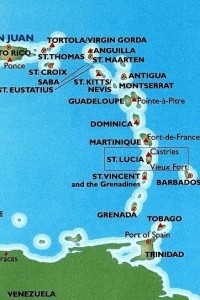 From St Maarten down the eastern Caribbean chain in late Spring, all any cruiser talks about is Grenada. How soon are you leaving for Grenada? Where are you stopping along the way to Grenada? How soon do you need to get to Grenada? Will you haul out or leave it in the water in Grenada? Do you know a reliable boat boy in Grenada? What does your insurance policy say about a named storm in Grenada? When was the last time a hurricane passed through Grenada? Everyone has slight variations of the same plan: enjoy the islands as much as possible before a June or July haul out in Grenada until September or October. We have to be below 12.5°N (i.e., Carriacou) by June 1st and plan to leave Blue Moon in the water for a few weeks while we go home in mid June. It’s a tough task to enjoy hiking volcanoes, snorkeling coral and kayaking coves when a hard and fast deadline looms that no one will stop talking about.
From St Maarten down the eastern Caribbean chain in late Spring, all any cruiser talks about is Grenada. How soon are you leaving for Grenada? Where are you stopping along the way to Grenada? How soon do you need to get to Grenada? Will you haul out or leave it in the water in Grenada? Do you know a reliable boat boy in Grenada? What does your insurance policy say about a named storm in Grenada? When was the last time a hurricane passed through Grenada? Everyone has slight variations of the same plan: enjoy the islands as much as possible before a June or July haul out in Grenada until September or October. We have to be below 12.5°N (i.e., Carriacou) by June 1st and plan to leave Blue Moon in the water for a few weeks while we go home in mid June. It’s a tough task to enjoy hiking volcanoes, snorkeling coral and kayaking coves when a hard and fast deadline looms that no one will stop talking about.
A lot of these boats have been traveling en masse since Florida, buddy boating along the way or hooking up again island after island. They talk about the marina in Fort Lauderdale or Georgetown where they met, crossings they’ve made together and boats that have turned back to be hauled out in Puerto Rico or docked in the northeast. They alter their navigation plans and travel schedules to stick together no matter what, catamarans shortening sail to slow down for their monohull buddy boat, boats holding back a few days to allow their buddy boat to finish repairs before the next jump. When we’re at anchor with them, we eaves drop over the radio and across the bar; no weather forecast or anchorage chart goes by without thorough discussion and debate. Safety in numbers, they must think.
Until St Maarten, we bucked the trend – we started late and need to finish early, we visited places no one else goes, we skipped places no one else misses, we sailed on days other boats hung back, and we sailed past staging areas where boats wait for weather windows. It seemed that the people we did stop to meet were headed in the opposite direction or moving at a completely different pace, just anchorage neighbors we waved to when pulling out but not anyone we keep in touch with. It made for an arduous and lonely first few months of the voyage – just the two of us, our sailboat, dinghy and kayak, and whatever Mother Nature decided to throw at us (gale force winds, big seas with short periods, squalls, dolphins, turtles, sharks and whales!).
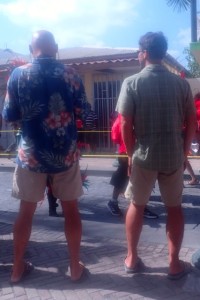
Going it alone for the first few months also makes this month all the more enjoyable, as we relish in the social interaction, the cruisers we hadn’t yet met, the stories we haven’t yet heard. The average age of cruisers south of 20°N latitude is about twenty to thirty years younger than north of it; we’re meeting families with school-age kids aboard, couples in their forties grappling with whether to return to careers, adventurous able bodies ready to hike with us, sailors we identify with. I’d been following the blogs of a few Manhattan Sailing Club students and members cruising down here, hoping to track them down. We finally caught up with Livin’ Life in Dominica and hope to meet up with Two Fish in Grenada. In St Maarten we fell into cahoots with a fellow Packateer (i.e., an Island Packet owner, bestowed the corny nickname by other sailors envious of our solid rigging, our shallow keel and our Harley-Davidson-cult-like following). Steve and I hike every hill that comes before us, and he and Jason monkey with electronics, computers and mechanics while kicking back the beers. It’s been fun having a buddy boat – especially one that points into the wind as poorly, and moves as slowly, as we do. I imagine we’ll miss him dearly when he heads south to Trinidad. (Yes, Steve, you’re famous! It’s your third appearance in a blog.)
The sailing has gotten better; we are no longer banging our head against a wall, trying to sail directly into the wind, finally having solid wind on our beam. We’re also done with long passages for a while, just day sailing from island to island. Bare boat charterers who make it this far are conscious of the fact that they’re out of their league – “We’re not in the BVIs anymore, Toto.” – and need help anchoring. Cruisers that have made it this far aren’t afraid of a strong wind, a long overnight, or a tough anchorage, and they’ve got the stories to back it.
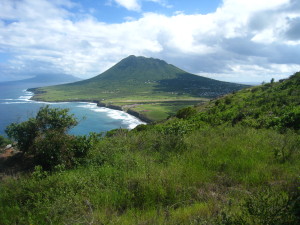
The islands have gotten interesting. They are all volcanic. A conical dormant volcanic mountain beckons us to climb it as soon as we’ve set anchor; the paths up are lush and green, full of fruit trees and iguanas. There is always a possibility of an eruption, like on Martinique in 1902 and Montserrat in 1995.
They are all European – either dependent departments, municipalities or territories (e.g., St Maarten (Dutch and French), Saba (Dutch), St Eustatius (Dutch), Montserrat (British), Guadeloupe (French), Martinique (French) and St Barthelemy (French)) or former colonies now independent (e.g., Dominica, St Kitts and Nevis, Antigua and Barbuda, Barbados and Grenada, in each case British colonies until independence in the late twentieth century). French food, deep Creole accents, and European-flagged vessels abound. It’s like backpacking through Europe 15 years ago, but I’m not 20 years old anymore, we travel by boat instead of train, and the unified currency is finally implemented. I can hear my elementary school French teacher sing-songing “Bon Jour” and “Merci” in my head during every interaction I have with the French islanders – but mostly I stutter some incomprehensible amalgamation of Spanish, Portuguese, Japanese and English. Customs and immigration on several of the islands is computerized, much more civilized than the outdated carbon-paper long handwritten forms. And with the Euro crashing against the US Dollar as Greece teeters toward leaving the unified currency, we’ve filled our holds with cheap French wine and our fridge with cheap French cheese.
-
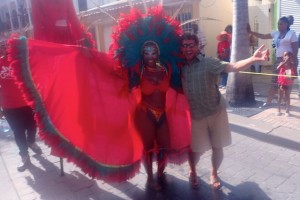
St Maarten Carnival St Maarten/St Martin: A half Dutch, half French island overrun with cruisers. After nearly a week of social events, including a day at Carnival, a Dinghy Drift, a day at Friar’s Beach Club, and too many happy hours at Lagoonies and St Maarten Yacht Club, we had to sail off to give our livers a rest. Budget Marine was almost as good as West Marine stateside, and groceries were great. Bummer the Simpson Lagoon water is not swimmable.
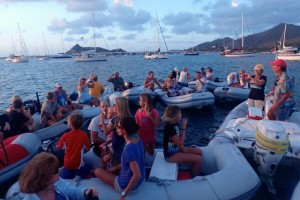
-
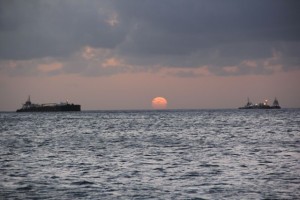
Statia Tankers St Eustatius: We were getting rounded up into gale force winds (35+ knots!) just as we rounded the tip of Statia, dodging between all the oil tankers anchored, docked and piloting there. Statia is an oil storage depot, bringing in massive tankers from all over the world. For us, Statia was great snorkeling and a big volcano (The Quill, 1972 feet) to hike.
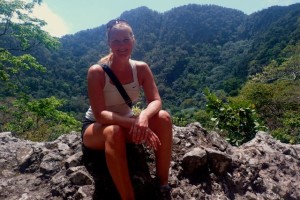
-
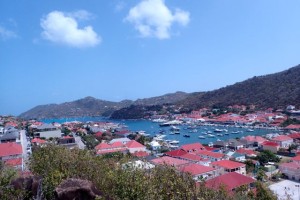
Gustavia, St Barths St Barthelemy: St Barths offseason is perfect for us: quiet anchorages, good hiking, diving and snorkeling, and great French wine and cheese. Not a bad place to wait for the wind to settle for a few days. St Barths during the season would probably have caused me to weigh anchor before we’d even checked in: high end luxury shopping, lots of French people rattling in French, and anchorages full of mega yachts. At an outdoor café facing the harbor, not a single table (other than ours) didn’t have at least one box of cigarettes on it; France appears not have received the decades old news that smoking kills. At our quiet, small anchorage in Anse de Colombier on the northwest coast, about an hour before sunset, 30 local sailboats came in under full sail with winds gusting over 25 knots to anchor between the mooring balls where about 10 cruising sailboats were moored. There was at least one collision, several near misses, and lots of gesturing and shouting in French (“Why did you anchor here? You knew I was going to anchor here!” (cue Jason’s corny French accent)). Luckily they pulled out the next day and left us to enjoy our paradise.
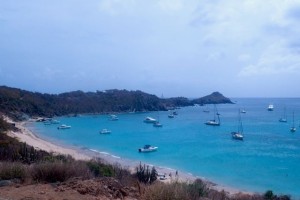
-
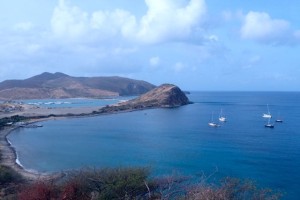
Whitehouse Bay, St Kitts St Kitts and Nevis: We walked around Basseterre carrying gasoline and propane tanks, until a kind local picked us up and drove us to the appropriate stations to get fuel. Jason had to remind me that we were carrying explosives every time I suggested we stop at a bar for a drink on the way back to boat. At Whitehouse Bay, Jason had a great snorkel with turtles and Steve and I had a great hike to Cockleshell Bay. In Nevis, Steve and I hiked the volcano (Nevis Peak, 3232 feet) after we took a wrong turn on an easier trail, while Jason waited for us at the beach side bar Sunshine.

-
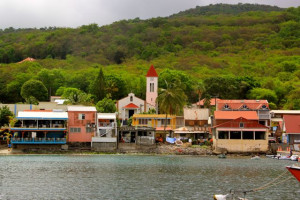
Deshaies, Guadeloupe Guadeloupe: Guadeloupe was one of the islands I knew we couldn’t miss – I had read about its big lush hills and crystal blue waters. In Deshaies, Jason and I made my first of many failed attempts to hike to a waterfall, having to turn back as the sun was setting. The snorkeling and diving in Pigeon Island’s Cousteau National Park was incredible.
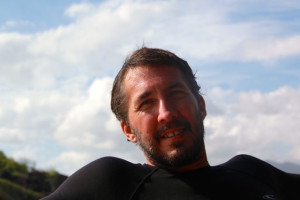
In Iles des Saintes, Steve and I hiked Le Chameau for a view of the beautiful islands off the south coast of Guadeloupe.
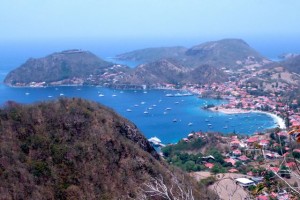
I hope to go back someday and hike some more of Guadeloupe’s hills and swim more of its waters.
-
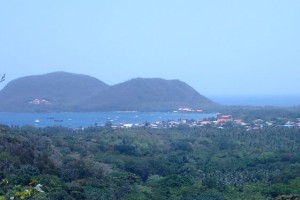
Portsmouth, Dominica Dominica: Dominica was Jason’s favorite island from his last trip through the chain – the place he’d wished he’d spent more time. It has rainforest covered mountains and volcanoes, and the boat boys have organized themselves to ensure an efficient, reliable, hassle free, personable service. We didn’t receive such a warm reception this time, sadly. We did enjoy the boat boys’ fish fry, and the jazz fest at Fort Shirley in the Cabrits National Park.
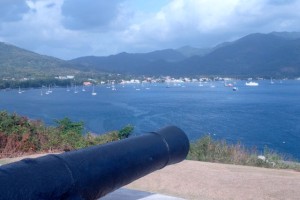
Steve and I made two failed attempts at hiking to a waterfall on the Waitukubuli National Trail, the first because of 8 miles of wrong turns and the second because apparently the waterfall dries up in dry season (oops).
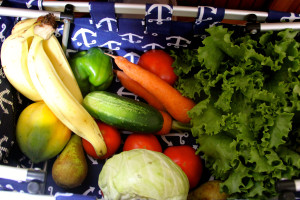
The Farmer’s Market in Portsmouth refilled our dwindling produce supply better than expected, including the frog that came in the lettuce – our first stowaway!
If we’d had a few more days, I would have liked to have hiked more of Dominica’s mountains and visited more of its (maybe dry?) waterfalls.
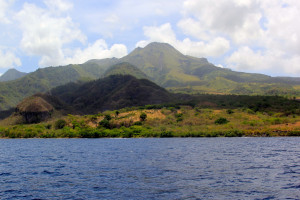
- Martinique: Martinique was an unexpected treat. We stopped because it made sense distance wise, but were delighted by the warm humor of the locals. Steve and I hitched rides from three different locals to make it to and from the base of the volcano we hiked (Mt Pelee, 4020 feet), all of whom tried conversation despite our non-existent French, and resorted to a gregarious smile and handshake when that failed. We had an incredible meal at Le Tamaya in St Pierre – the best French food I’ve ever had and the nicest French waitress we’ve ever met. We used our last euros to buy Lorraine beers in Anse Mitan before leaving the French Antilles in our wake.
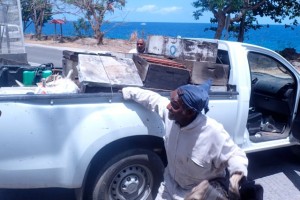
-

Bequia Bequia, Grenadines: Jason raved about the islanders he’d met on shore and how soft spoken and helpful they were; I told him a boat boy had stared me down and cursed at me for anchoring (not at all) near his (illegal) mooring ball, and when Jason approached him to ask what the issue was he cursed some more, called me nasty names and threatened to give Jason “a smack”. It sadly sums up our experience in the entire chain – a handful of really good interactions spoiled by one or two really awful ones on each island. I think it means we’re ready for a break from island hopping.
We’re sailing well outside of the box. We missed a few islands along the way that I would have liked to have visited – Anguilla, Saba, Antigua, Barbados, Barbuda, Montseratt, St Lucia, St Vincent and more of the Grenadines – because time was precious, the wind was in the wrong direction, or they just didn’t seem very attractive from a cruiser’s point of view. But we’ve sailed further than we’d sailed before: I had never sailed east of Virgin Gorda in the British Virgin Islands, and Blue Moon had never been south of Dominica. When we finally set sail west from Grenada for the Panama Canal later this year, it will be entirely new territory for vessel and crew. I’m excited to venture on. First, some tender loving care for s/v Blue Moon before we leave her in Grenada, then a few weeks on land in New York and Michigan with family and friends. Land is in sight!

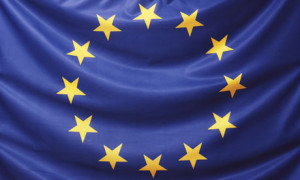
WOW!
Great writing, as usual. You’ve paved the way for our travels next fall. Eric & Debbie – INDIGO
Interesting trip-seems Jason’s not a hiker, preferring more sedate pursuits. There are many ways to see places. Later when you head for the Canal-be sure to check out the San Blas Islands and the resident Kuna Indians.That will end your Caribbean trip on a high note. The canal trip is great-especially surrounded by humongous Panamax and the newer group. You should take a look at Panama-the city and whatever else you might have time for. US $ there too.